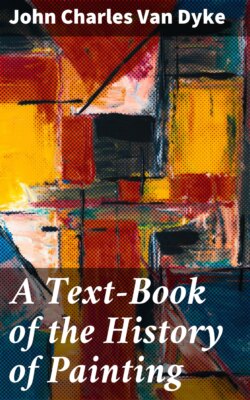Читать книгу A Text-Book of the History of Painting - John Charles Van Dyke - Страница 13
На сайте Литреса книга снята с продажи.
ETRUSCAN AND ROMAN PAINTING.
ОглавлениеTable of Contents
Books Recommended: See Bibliography of Greek Painting and also Dennis, Cities and Cemeteries of Etruria; Graul, Die Portratgemalde aus den Grabstatten des Faiyum; Helbig, Die Wandgemalde Campaniens; Helbig, Untersuchungen uber die Campanische Wandmalerei; Mau, Geschichte der Decorativen Wandmalerei in Pompeii; Martha, L'Archéologie Étrusque et Romaine.
ETRUSCAN PAINTING: Painting in Etruria has not a great deal of interest for us just here. It was largely decorative and sepulchral in motive, and was employed in the painting of tombs, and upon vases and other objects placed in the tombs. It had a native way of expressing itself, which at first was neither Greek nor Oriental, and yet a reminder of both. Technically it was not well done. Before 500 B.C. it was almost childish in the drawing. After that date the figures were better, though short and squat. Those on the vases usually show outline drawing filled in with dull browns and yellows. Finally there was a mingling of Etruscan with Greek elements, and an imitation of Greek methods. It was at best a hybrid art, but of some importance from an archæological point of view.
ROMAN PAINTING: Roman art is an appendix to the art history of Greece. It originated little in painting, and was content to perpetuate the traditions of Greece in an imitative way. What was worse, it copied the degeneracy of Greece by following the degenerate Hellenistic paintings. In motive and method it was substantially the same work as that of the Greeks under the Diadochi. The subjects, again, were often taken from Greek story, though there were Roman historical scenes, genre pieces, and many portraits.
FIG. 15.—RITUAL SCENE, PALATINE WALL PAINTING. (FROM WOLTMANN AND WOERMANN.)
In the beginning of the Empire tablet or panel painting was rather abandoned in favor of mural decoration. That is to say, figures or groups were painted in fresco on the wall and then surrounded by geometrical, floral, or architectural designs to give the effect of a panel let into the wall. Thus painting assumed a more decorative nature. Vitruvius says in effect that in the early days nature was followed in these wall paintings, but later on they became ornate and overdone, showing many unsupported architectural façades and impossible decorative framings. This can be traced in the Roman and Pompeian frescos. There were four kinds of these wall paintings. (1.) Those that covered all the walls of a room and did away with dado, frieze, and the like, such as figures with large landscape backgrounds showing villas and trees. (2.) Small paintings separated or framed by pilasters. (3.) Panel pictures let into the wall or painted with that effect. (4.) Single figures with architectural backgrounds. The single figures were usually the best. They had grace of line and motion and all the truth to nature that decoration required. Some of the backgrounds were flat tints of red or black against which the figure was placed. In the larger pieces the composition was rather rambling and disjointed, and the color harsh. In light-and-shade and relief they probably followed the Greek example.
FIG. 16.—PORTRAIT-HEAD. (FROM FAYOUM, GRAF COL.)
ROMAN PAINTERS: During the first five centuries Rome was between the influences of Etruria and Greece. The first paintings in Rome of which there is record were done in the Temple of Ceres by the Greek artists of Lower Italy, Gorgasos and Damophilos (fl. 493 B.C.). They were doubtless somewhat like the vase paintings—profile work, without light, shade, or perspective. At the time and after Alexander Greek influence held sway. Fabius Pictor (fl. about 300 B.C.) is one of the celebrated names in historical painting, and later on Pacuvius, Metrodorus, and Serapion are mentioned. In the last century of the Republic, Sopolis, Dionysius, and Antiochus Gabinius excelled in portraiture. Ancient painting really ends for us with the destruction of Pompeii (79 A.D.), though after that there were interesting portraits produced, especially those found in the Fayoum (Egypt).[1]
[1] See Scribner's Magazine, vol. v., p. 219, New Series.
EXTANT REMAINS: The frescos that are left to us to-day are largely the work of mechanical decorators rather than creative artists. They are to be seen in Rome, in the Baths of Titus, the Vatican, Livia's Villa, Farnesina, Rospigliosi, and Barberini Palaces, Baths of Caracalla, Capitoline and Lateran Museums, in the houses of excavated Pompeii, and the Naples Museum. Besides these there are examples of Roman fresco and distemper in the Louvre and other European Museums. Examples of Etruscan painting are to be seen in the Vatican, Cortona, the Louvre, the British Museum and elsewhere.
